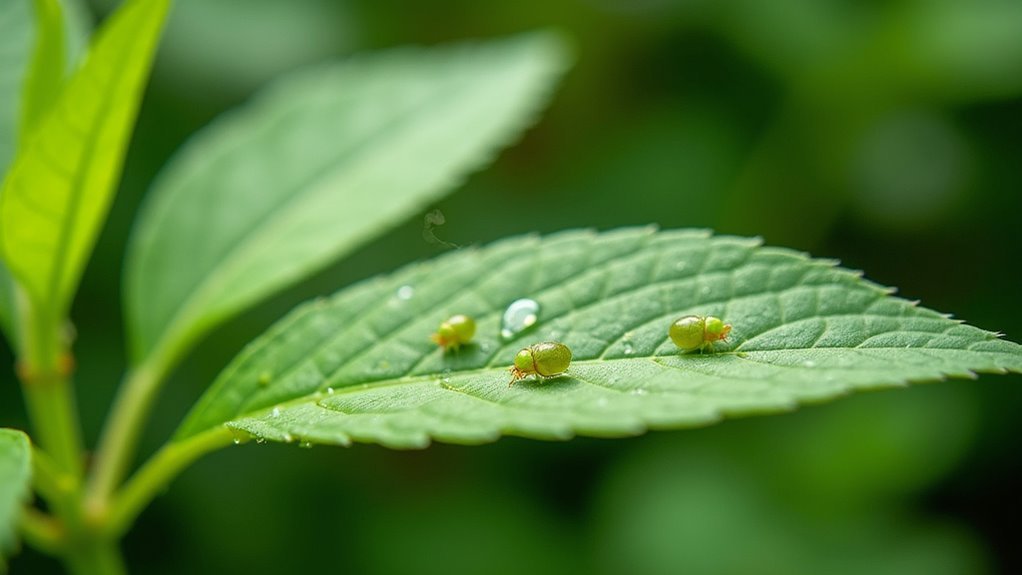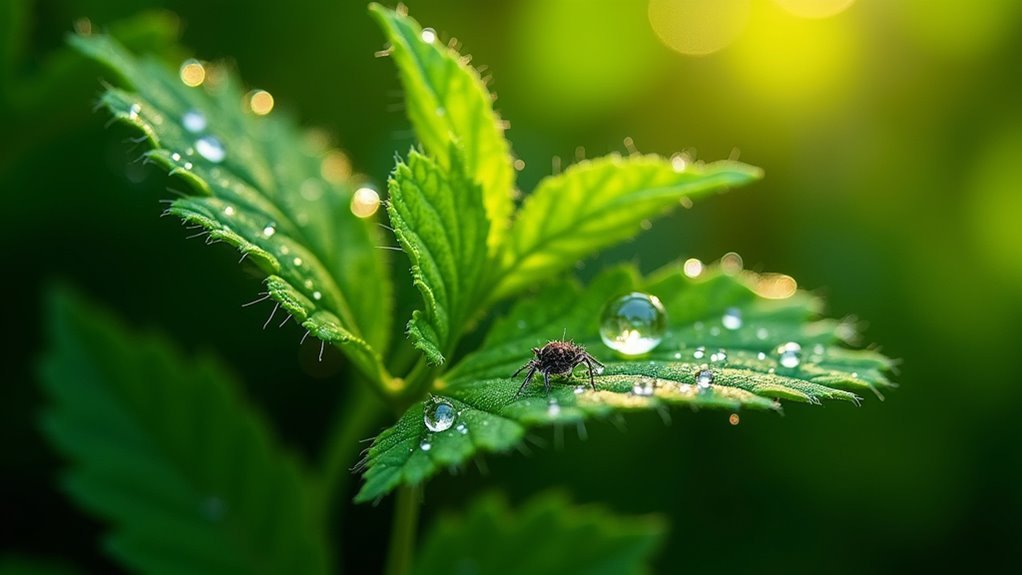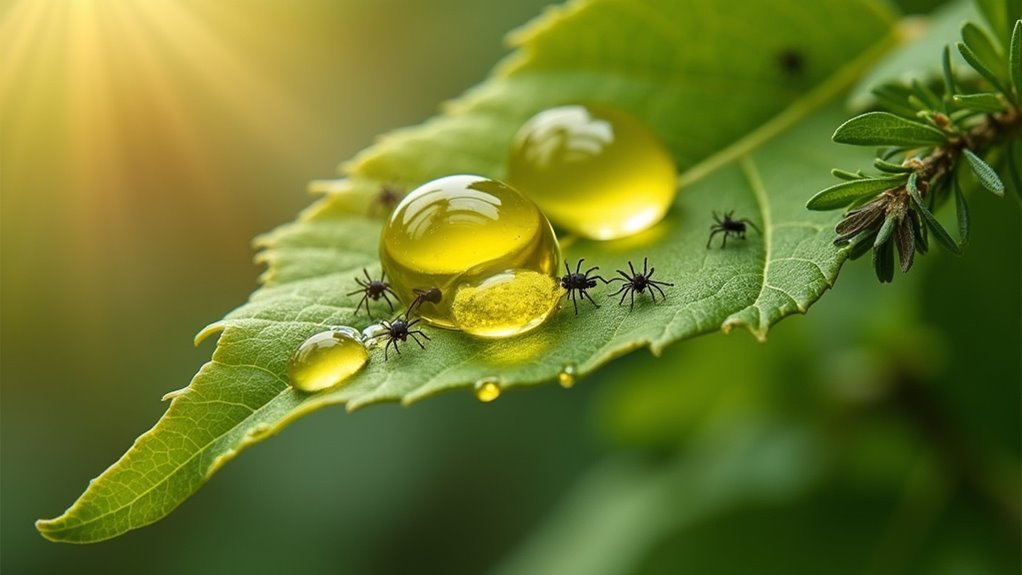You can effectively eliminate spider mites using neem oil through seven proven treatments: a basic spray mixing 1 teaspoon neem oil per quart of water for light infestations, a concentrated solution using 2 ounces per gallon for severe problems, combining neem oil with insecticidal soap for enhanced effectiveness, establishing a weekly application schedule for prevention, targeting leaf undersides where mites hide, and creating an enhanced formula with garlic and chili peppers. These natural approaches will give you thorough control over your spider mite problems.
Understanding How Neem Oil Works Against Spider Mites

The natural compound azadirachtin in neem oil disrupts spider mites’ reproductive cycles, preventing them from laying eggs and multiplying on your plants. This effective pest control method works through multiple mechanisms to eliminate infestations.
Azadirachtin naturally breaks spider mites’ breeding patterns, stopping egg production and preventing population explosions on your plants.
When you spray neem oil directly onto affected areas, it acts as a contact insecticide that coats the mites, smothering them while interfering with their feeding hormones. This leads to starvation and population decline.
You’ll find neem oil particularly effective when you target the undersides of leaves where spider mites typically hide. Unlike harsh chemical alternatives or insecticidal soap, this environmentally friendly solution won’t harm beneficial insects, humans, or pets.
Regular application every 7-10 days guarantees maximum effectiveness against persistent infestations.
Basic Neem Oil Spray Recipe for Light Infestations
Now that you understand neem oil’s effectiveness against spider mites, you’ll need the right mixture to tackle light infestations before they spread. Creating an effective spray is straightforward and requires minimal ingredients.
For basic spider mite control on your plants, follow this simple recipe:
- Mix 1 quart water with 1 teaspoon concentrated neem oil and ½ teaspoon dish soap
- Shake thoroughly until neem oil distributes evenly throughout the mixture
- Transfer to a spray bottle for easy application on affected plants
- Apply to both leaf tops and undersides where spider mites typically hide
- Spray during early morning or evening hours to prevent leaf burn
Repeat applications every seven days until spider mite activity decreases, ensuring consistent treatment for ideal results.
Concentrated Neem Oil Solution for Severe Spider Mite Problems

When spider mites have severely infested your plants, you’ll need a more potent neem oil solution that requires careful mixing and strategic application timing.
You must increase both the concentration and frequency of treatments while taking extra safety precautions to protect your plants from potential damage.
This stronger approach demands attention to proper dilution ratios, spray scheduling, and protective measures during application.
Mixing Concentrated Neem Oil
For severe spider mite infestations that demand aggressive intervention, you’ll need to prepare a concentrated neem oil solution that packs more punch than standard treatments.
Mixing concentrated neem oil requires precision to guarantee maximum effectiveness against these persistent pests.
Create your potent solution using these steps:
- Mix 2 ounces of neem oil with 1 gallon of water
- Add several drops of liquid dish soap for better emulsification
- Shake the mixture vigorously before each application
- Apply the neem oil solution thoroughly to undersides of leaves where mites hide
- Reapply the concentrated neem oil solution every 7-10 days
Always perform a patch test first to check plant sensitivity.
Neem oil is effective when properly mixed and consistently applied during spider mite infestation treatment.
Application Frequency for Infestations
Since spider mites reproduce rapidly and can quickly rebound after initial treatment, you’ll need to maintain a weekly application schedule with your concentrated neem oil solution.
Apply neem oil every seven days to disrupt their reproductive cycle and prevent population resurgence. Target all plant leaves thoroughly, paying special attention to undersides where these pests commonly hide.
Your water spray mixture should contain 2 oz of neem oil per gallon of water with liquid dish soap for better coverage.
Continue weekly treatments until you no longer see webbing or leaf damage indicating active infestations. This consistent approach guarantees you’re eliminating existing spider mites while preventing new generations from establishing themselves on your plants.
Safety Precautions When Spraying
Although concentrated neem oil solutions effectively combat severe spider mite infestations, you must follow essential safety protocols to protect both yourself and your plants.
When applying neem oil, always dilute it properly using 2 oz per gallon of water to prevent leaf burn. This non-toxic to humans treatment still requires careful handling:
- Test a small plant area first to check for sensitivity before broad application
- Apply during morning or evening hours to avoid direct sunlight damage
- Spray to dislodge webbing while guaranteeing thorough coverage of leaf tops and undersides
- Keep pets and humans away from treated areas until completely dry
- Wear protective clothing and avoid inhaling the spray to guarantee safety
These precautions maximize treatment effectiveness while minimizing risks.
Neem Oil and Insecticidal Soap Combination Treatment

You’ll find that combining neem oil with insecticidal soap creates a more powerful treatment against spider mites than using either product alone.
The key to success lies in getting your mixing ratios right and applying the solution at ideal intervals to break the spider mites’ reproductive cycle.
This enhanced approach doesn’t just kill existing pests—it also provides longer-lasting protection that keeps your plants healthier over time.
Mixing Ratios and Proportions
Creating the perfect neem oil and insecticidal soap mixture requires precise measurements to maximize effectiveness while protecting your plants from damage.
Getting these ratios right guarantees your spray will eliminate spider mites without harming your vegetation.
Follow these essential mixing guidelines for ideal results:
- Base mixture: Combine 2 ounces of neem oil with 1 gallon of water
- Soap addition: Add 1-2 teaspoons of liquid dish soap to enhance emulsification
- Thorough mixing: Blend completely to prevent oil separation that damages leaves
- Application focus: Spray generously on all plant surfaces, especially leaf undersides
- Safety first: Test on a small plant area before full application
Mix fresh solution for each treatment and reapply every 7-10 days until spider mites are completely eliminated from your plants.
Application Timing and Frequency
Beyond simply mixing your neem oil and insecticidal soap solution correctly, timing your applications strategically determines whether you’ll achieve complete spider mite elimination or face recurring infestations.
Apply treatments during morning or evening hours to prevent leaf burn and maximize effectiveness. Spray the entire plant thoroughly, concentrating on leaf undersides where spider mites typically hide.
For severe infestations, you’ll need to re-apply every 7-10 days to maintain control over populations. Don’t skip this schedule—spider mites reproduce rapidly, and inconsistent application timing allows them to reestablish.
Focus on monitoring plants regularly after each treatment to assess progress. If you notice continued mite activity, adjust your frequency accordingly.
Consistent timing and thorough coverage guarantee successful elimination.
Enhanced Effectiveness Benefits
When you combine neem oil with insecticidal soap, you’re creating a dual-action treatment that delivers both immediate knockdown power and long-term protection against spider mites. This powerful pest control combination works on multiple fronts to reduce populations effectively.
- Immediate contact action – Insecticidal soap provides instant knockdown while neem oil smothers mites on contact.
- Disrupted life cycles – Neem oil interferes with feeding and reproductive processes for long-term control.
- Enhanced coverage – The soap helps remove protective webbing while neem oil creates lasting residue on plant surfaces.
- Prevention barrier – Treated areas become less hospitable for reinfestation attempts.
- Comprehensive protection – Regular application every 7-10 days maintains continuous defense against future outbreaks.
Weekly Neem Oil Application Schedule for Prevention
Establishing a consistent weekly neem oil application schedule serves as your most effective defense against spider mite infestations before they can gain a foothold in your garden. Apply treatments every 7-10 days using 2 oz neem oil per gallon of water, adding liquid dish soap for better mixing. Target both upper and underside of leaves where mites typically hide.
| Schedule | Timing | Coverage |
|---|---|---|
| Week 1 | Morning/Evening | Full plant spray |
| Week 2 | Morning/Evening | Focus on leaf undersides |
| Week 3 | Morning/Evening | Complete treatment |
| Week 4 | Morning/Evening | Monitor and treat |
| Ongoing | As needed | Adjust frequency |
Monitor plants between applications to prevent infestations. If populations begin to rise, increase application schedule frequency immediately.
Targeted Neem Oil Treatment for Leaf Undersides
Since spider mites prefer to congregate on leaf undersides where they’re protected from predators and environmental stress, you’ll need to angle your spray nozzle upward to achieve direct contact with these hidden populations.
Effective targeting requires proper preparation and technique:
- Mix 2 oz neem oil per gallon of water with liquid dish soap for better adhesion
- Always perform a patch test on sensitive plants before full application
- Apply during morning or evening hours to prevent leaf burn from heat
- Focus spray coverage on underside of leaves where mites and eggs cluster
- Reapply every 7-10 days to disrupt the reproductive cycle
This targeted approach guarantees you’re hitting spider mites where they actually live and breed, preventing new infestations from taking hold in your garden.
Enhanced Neem Oil Formula With Natural Additives
While basic neem oil treatments work effectively against spider mites, you’ll achieve superior results by enhancing your formula with natural additives that amplify the oil’s pest-fighting power.
Create your enhanced neem oil formula by adding garlic and chili pepper, which repel spider mites while making your treatment more hostile to pests. Mix in liquid soap to emulsify the oil properly, ensuring uniform application that penetrates waxy leaf surfaces where mites hide.
Essential oils like peppermint or clove boost potency and add pleasant scents. Use warm water when mixing to improve dispersion and coverage.
Apply this enhanced formula every 7-10 days for maximum pest control, disrupting spider mite life cycles through regular application.
Frequently Asked Questions
What Is the Fastest Way to Get Rid of Spider Mites on Plants?
You’ll get fastest results by spraying plants with a strong water jet to dislodge mites, then applying 70% isopropyl alcohol spray every other day until infestation’s completely eliminated.
How Often Should I Apply Neem Oil for Mites?
You should apply neem oil every 7-10 days for regular spider mite control. For severe infestations, you’ll need to reapply every 5-7 days until the mite population decreases considerably.
What Is the Best Homemade Spider Mite Killer?
You’ll find the best homemade spider mite killer combines 1 quart water, 1 teaspoon neem oil, and ½ teaspoon dish soap. This solution’s contact properties effectively eliminate mites while preventing future infestations.
How Do You Make Neem Oil Spray for Mites?
You’ll mix 1 quart of water with 1 teaspoon of concentrated neem oil and ½ teaspoon of dish soap. Shake well before applying to guarantee proper emulsification and even distribution throughout the solution.
In Summary
You’ve now got seven proven neem oil treatments to tackle spider mites at any stage of infestation. Start with the basic spray for early detection, then scale up to concentrated solutions if needed. Don’t forget to target leaf undersides where mites hide, and stick to your weekly prevention schedule. With consistent application and the right formula strength, you’ll keep your plants spider mite-free naturally.





Leave a Reply